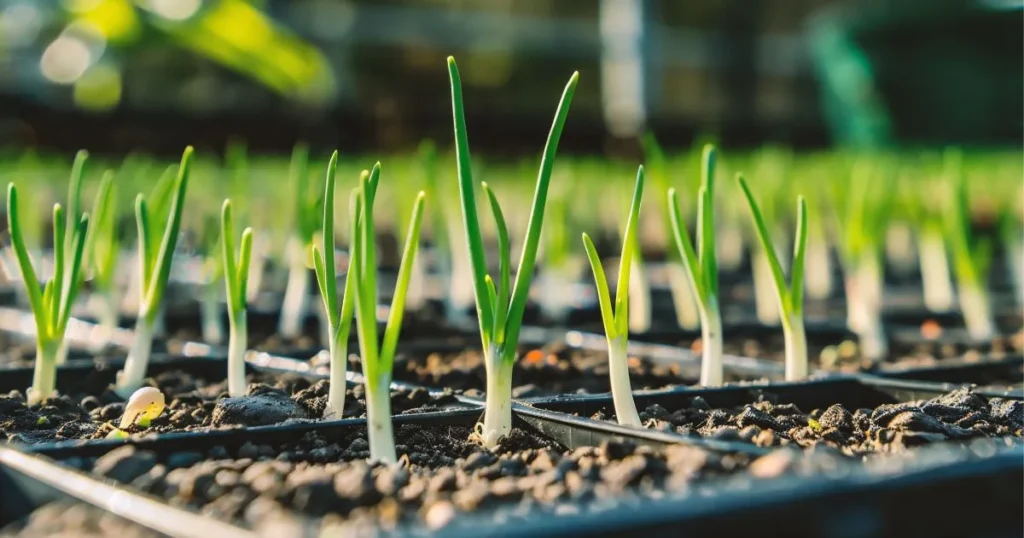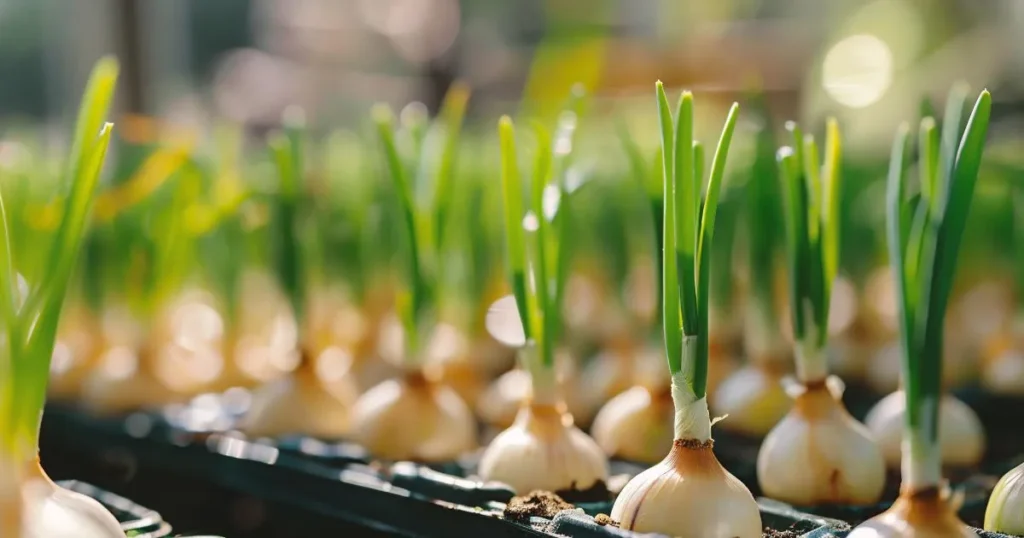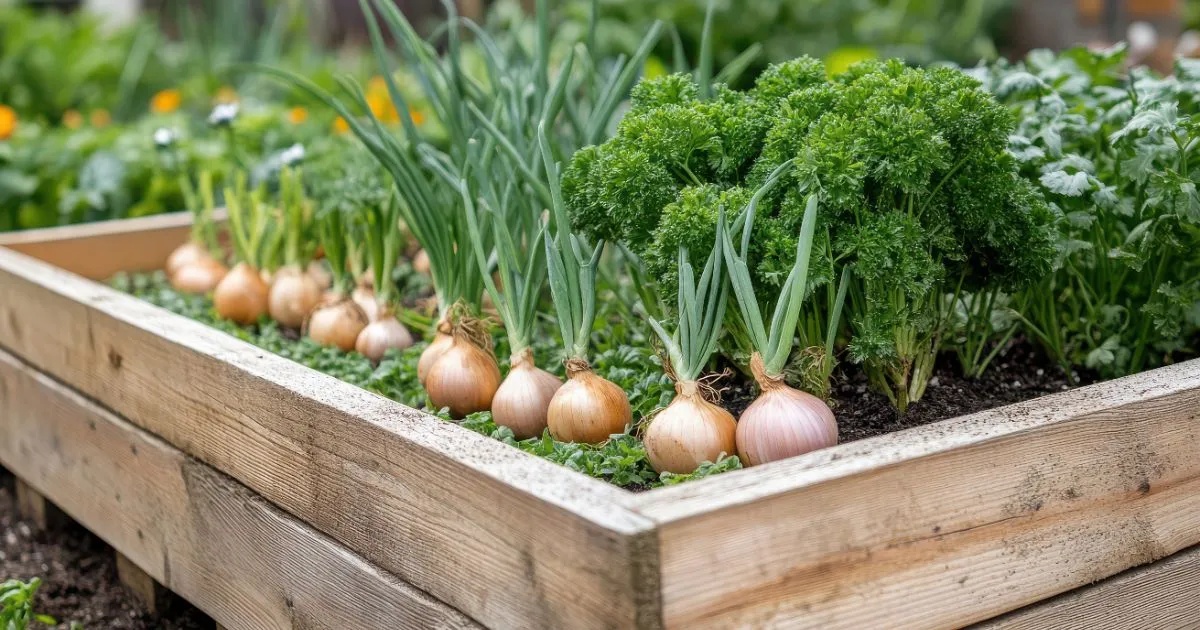Table of Contents
How to Grow Onions in Containers:
Growing onions in containers is an excellent way to enjoy fresh, homegrown produce, especially for those with limited space. Whether you’re gardening on a balcony, patio, or windowsill, container gardening can provide a convenient and productive solution for growing onions. In this article, we’ll explore how to grow onions in containers, offering step-by-step guidance, tips, and advice. From choosing the right container to harvesting your onions, we’ll cover everything you need to know about this rewarding gardening venture.
Why Grow Onions in Containers?
Growing onions in containers offers numerous benefits. For one, it allows gardeners who don’t have a traditional garden bed to enjoy homegrown onions. Container gardening also gives you better control over the growing environment, such as soil conditions, water drainage, and sunlight exposure. Whether you’re growing onions for their bulbs or their greens, containers are versatile and manageable. But how to grow onions in containers effectively requires some careful planning and consideration.
Key Benefits of Growing Onions in Containers
- Space-saving: Ideal for small spaces like apartments, balconies, or urban gardens.
- Better soil control: Containers allow for easy management of soil quality and pH levels.
- Fewer pests and diseases: With the right care, container onions are less likely to suffer from common garden pests.
- Portability: Containers can be moved to optimize sunlight or protect plants from extreme weather conditions.
Choosing the Right Container for Growing Onions
When you’re figuring out how to grow onions in containers, the first step is selecting the right container. Onions need ample space for their roots to spread out, but not all containers are created equal. Here’s what to consider when choosing your container.
Size and Depth
Onions have relatively shallow roots, so you don’t need extremely deep containers. However, the container should still be large enough to give the plants room to grow. A good rule of thumb is to choose a container that is at least 10-12 inches deep and wide enough to accommodate 2-3 onion plants. For bulb onions, you’ll need about 6 inches of space between each plant. Larger containers (such as raised beds or barrels) can be ideal if you’re growing a larger batch of onions.
Material of the Container
Containers can be made from various materials, including plastic, clay, and fabric. Here’s a breakdown of the pros and cons of each:
- Plastic containers: Lightweight, affordable, and retain moisture well.
- Clay or terracotta pots: Attractive and breathable, but tend to dry out faster than plastic.
- Fabric pots: Promote healthy root growth through better aeration and drainage, though they may require more frequent watering.
Ultimately, the best container is one that offers good drainage, is large enough for your onions, and suits your aesthetic preferences.
Selecting Onion Varieties for Containers
When deciding how to grow onions in containers, it’s essential to choose the right variety. While many onion varieties can be grown in containers, some are more suitable for confined spaces than others. Here are the most common types of onions that do well in containers:
Bulb Onions
These are the most popular onions, and they typically form large bulbs. Bulb onions need a bit more space to grow and are usually better suited to larger containers. Popular varieties include:
- Yellow onions: These are the standard, all-purpose onion variety.
- Red onions: Known for their sweet, mild flavor and purple hue.
- White onions: These are often used for pickling or raw consumption.

Green Onions (Scallions)
If you’re looking for a faster-growing option, green onions (scallions) are perfect for container gardening. They don’t need as much space and grow quickly, often ready for harvest in 6-8 weeks.
Shallots
Shallots are another option for container gardening. They produce smaller bulbs compared to traditional onions but are prized for their mild flavor and culinary uses.
Chives
If you’re mainly interested in growing onion greens, chives are a great alternative. They’re easy to grow in small containers and thrive with minimal care.
Preparing the Container for Planting
Now that you’ve selected the right container and onion variety, the next step is preparing your container for planting. How to grow onions in containers effectively starts with the right preparation.
Step 1: Drainage
Good drainage is essential for onion health. Without proper drainage, your onions are susceptible to root rot. Make sure your container has several drainage holes at the bottom. If it doesn’t, you can easily drill holes yourself.
Step 2: Filling with Soil
Onions prefer well-draining, slightly acidic to neutral soil. A good potting mix designed for vegetables will work well, or you can mix your own using equal parts compost, perlite, and peat moss. Fill the container with soil to about 2 inches below the rim, allowing room for watering.
Step 3: Fertilizing the Soil
Before planting your onions, mix in a balanced, slow-release fertilizer to provide essential nutrients throughout the growing season. Onions are heavy feeders, so using a fertilizer high in nitrogen during the growing phase can help them develop strong tops and bulbs.
Planting Onions in Containers
Now that your container is ready, it’s time to plant your onions. Here’s a step-by-step guide to help you plant successfully.
Step 1: Choosing Seeds or Sets
You can grow onions in containers from seeds, sets, or transplants. Onion sets are small, immature bulbs that are the most common method for container growing. They’re easier to work with and faster to mature. Onion seeds, on the other hand, require a longer growing period and can be a bit trickier.
Step 2: Planting the Onions
If using onion sets, simply plant them 1-2 inches deep and about 4-6 inches apart. If you’re planting from seed, sow the seeds about 1/4 inch deep and thin them out as they grow.
For green onions, you can plant the seeds or sets about 1 inch apart, and they don’t need as much space for growth.
Step 3: Watering
Onions need consistent moisture, but they don’t like to sit in waterlogged soil. Water your onions thoroughly after planting, then keep the soil consistently moist but not soggy. Be sure to water early in the day to prevent fungal diseases.
Caring for Onions in Containers
Growing onions in containers requires some ongoing care. Here’s how you can ensure your plants stay healthy throughout the growing season.
Light Requirements
Onions are sun-loving plants and need at least 6 hours of direct sunlight each day to thrive. Make sure your container is placed in a sunny location, such as a south-facing patio or balcony. If you’re growing indoors, consider using grow lights to supplement natural sunlight.
Temperature and Weather
Onions are cool-season plants that grow best in temperatures between 55°F and 75°F (13°C – 24°C). They can tolerate some light frost but may struggle in extreme heat. If you live in a very hot climate, it might be a good idea to provide some shade during the hottest part of the day.
Feeding Your Onions
Onions are heavy feeders, so they benefit from regular fertilization. Use a balanced liquid fertilizer every 4-6 weeks during the growing season. If you’re growing onions for their bulbs, a higher-nitrogen fertilizer can promote top growth, while a phosphorus-rich fertilizer can encourage bulb development.
Pruning and Thinning
As your onions grow, be sure to thin them out to avoid overcrowding. This will help the remaining plants have more space to develop larger bulbs. If you’re growing green onions, trimming the tops as they grow will encourage new growth and make the plants more productive.
Harvesting Onions from Containers
Knowing when to harvest your onions is crucial for a successful crop. How to grow onions in containers isn’t complete without the harvest stage. Here’s what you should look for.
Harvesting Green Onions
Green onions are typically ready for harvest in about 6-8 weeks after planting. Simply pull them up when they reach the desired size. For continuous harvests, you can leave the roots in the soil, and new green tops will grow back.
Harvesting Bulb Onions
Bulb onions take longer to mature, typically around 90-120 days depending on the variety. When the tops begin to yellow and flop over, it’s a sign that the onions are ready for harvest. Gently pull them out of the soil, and let them dry in a shaded, well-ventilated area for a few weeks before storing them.

Conclusion
Growing onions in containers is a rewarding experience that doesn’t require a lot of space or advanced gardening skills. By following the right steps—choosing the right container, soil, and onion variety, providing consistent care, and harvesting at the right time—you can enjoy a bountiful crop of homegrown onions. Whether you’re growing onions for fresh use in your kitchen or for long-term storage, container gardening offers flexibility and convenience.
How to grow onions in containers isn’t difficult, but it does require attention to detail and proper care. With patience and proper maintenance, you can enjoy fresh onions from your own home, no matter how limited your space may be.
FAQ: How to Grow Onions in Containers
1. Can I grow onions in any container?
You need a container that is at least 10-12 inches deep with good drainage. Larger containers will provide more space for multiple plants.
2. Do onions grow well in pots?
Yes, onions can grow well in pots as long as the container provides enough space for the roots and the soil is well

